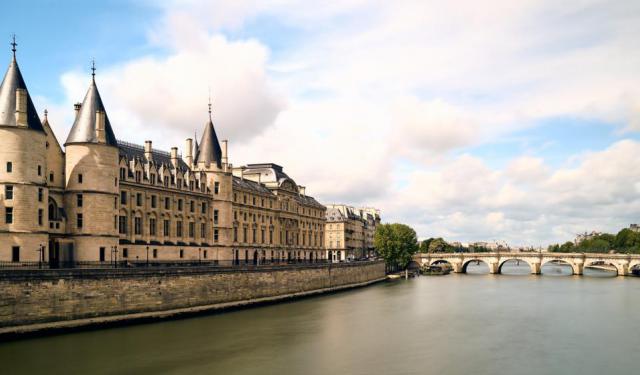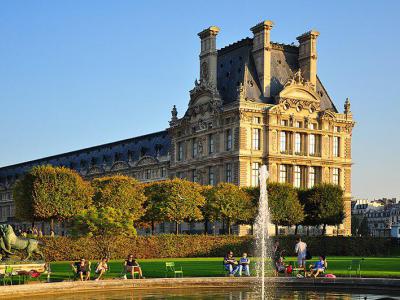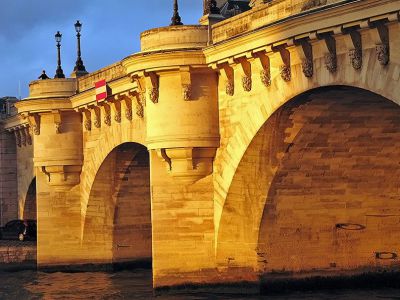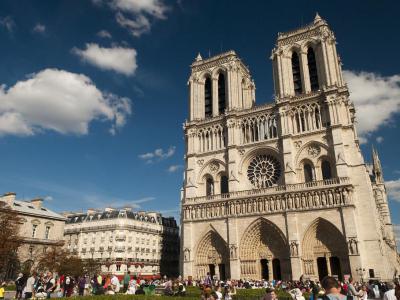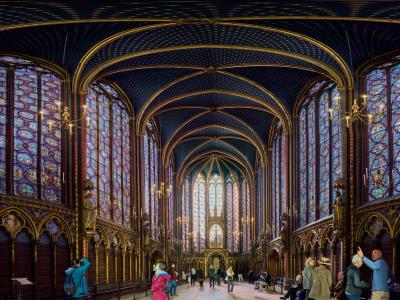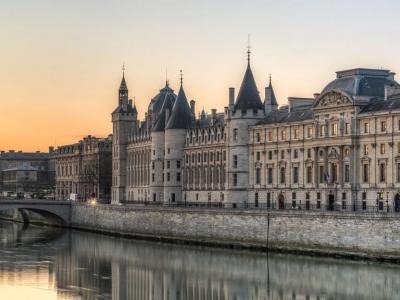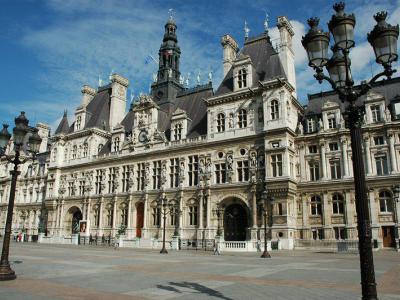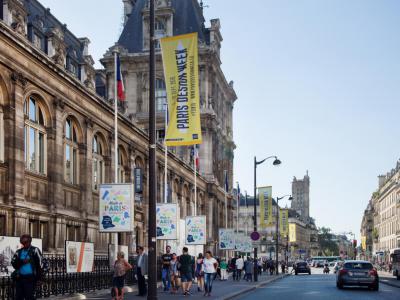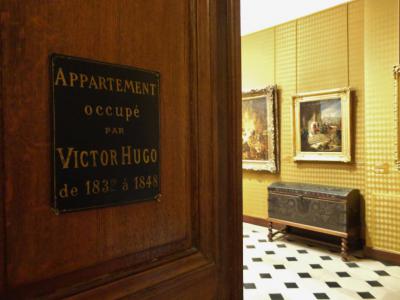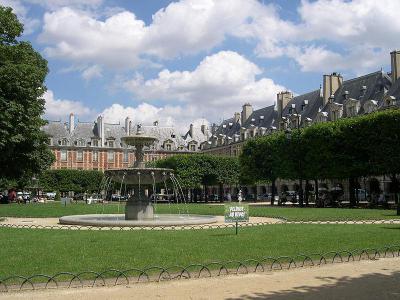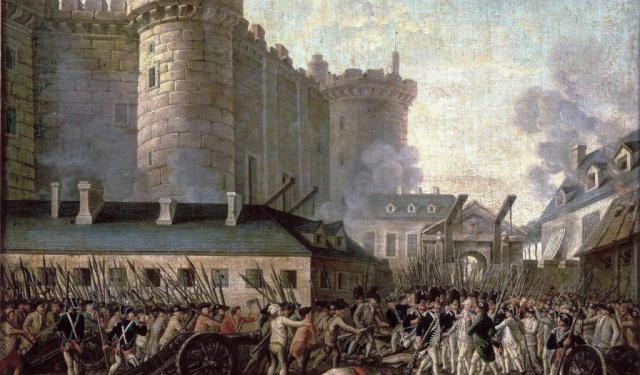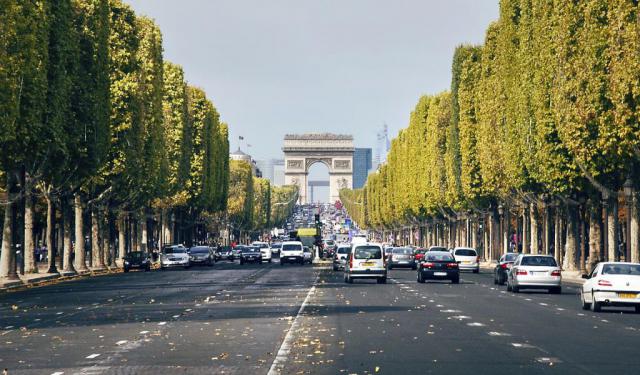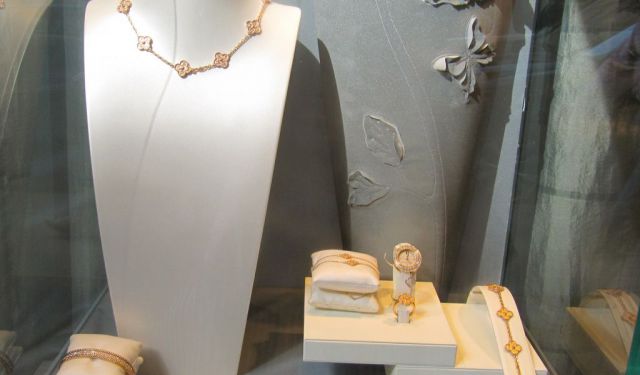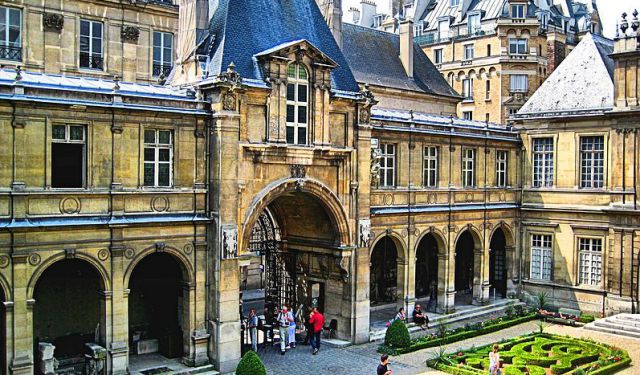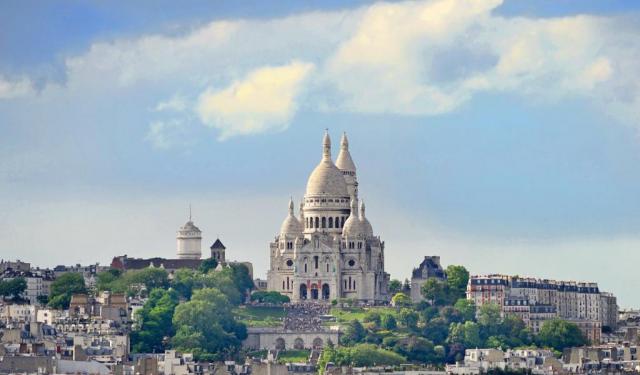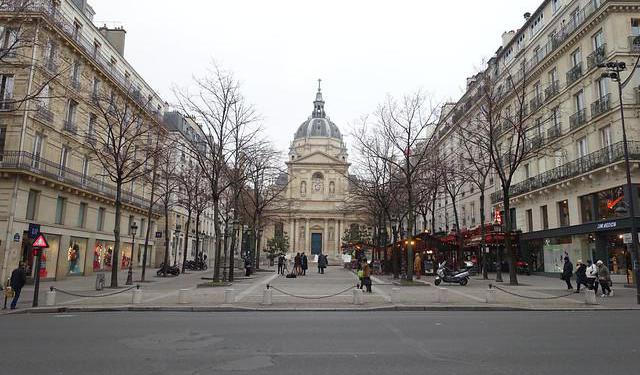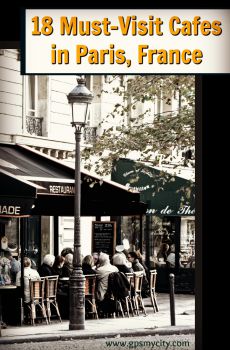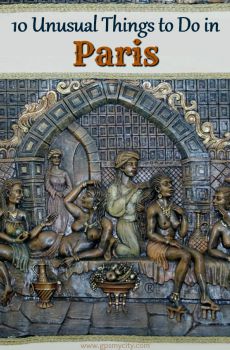Audio Guide: Paris Introduction Walking Tour II (Self Guided), Paris
As you continue your acquaintance with Paris driven by its timeless allure, the city's heart reveals itself with an array of places capturing its profound history and artistic legacy. The evolution of Paris is visible on the banks of the river Seine, the linking thread winding its way through the capital as if keeping a watchful eye on its architectural marvels.
The second part of our introductory tour is centered around the City Island and the Le Marais district, together forming the historical core of power in Paris. Along the way, we will explore some well-known landmarks firmly imprinted in the French revolutionary past, as well as some hidden gems.
The iconic Louvre Museum, home to the Mona Lisa and Venus de Milo, reflects Paris's influence in both ancient and modern art. Just a short walk away, the New Bridge is actually the oldest in town still in place, gracefully arching over the Seine since the early 17th century.
Across the river sits the majestic Notre-Dame Cathedral. Although currently under restoration, this iconic temple remains a Gothic masterpiece, its flying buttresses representing centuries of faith and craftsmanship. Nearby, the intimate Holy Chapel, commissioned by King Louis IX in the 13th century, dazzles with its stunning stained glass and is home to sacred relics.
Not far from it is the Conciergerie, once a medieval palace and later a prison. During the French Revolution, it held prisoners like queen consort Marie Antoinette, adding an air of historical weight to its impressive halls.
Not to be overlooked is Paris's grand City Hall, the center of municipal power and occasional drama since the 14th century. Its ornate Renaissance-style architecture today hosts government offices and cultural events.
For literature enthusiasts, a visit to the House Museum of Victor Hugo, the renowned French author, on Vosges Square is essential. One of Paris's oldest planned squares, Vosges Square embodies Parisian elegance with its uniform red-brick facades and lovely arcades, where visitors can take in the charm that so inspired Hugo.
To truly experience Paris, one must walk its streets, pause on its bridges, and marvel at its masterpieces. Each step through these sites enriches the story Paris continues to tell-a blend of romance, revolution, and reinvention. Let the city capture your imagination and uncover its layers with every corner you turn by joining us on this self-guided walk!
The second part of our introductory tour is centered around the City Island and the Le Marais district, together forming the historical core of power in Paris. Along the way, we will explore some well-known landmarks firmly imprinted in the French revolutionary past, as well as some hidden gems.
The iconic Louvre Museum, home to the Mona Lisa and Venus de Milo, reflects Paris's influence in both ancient and modern art. Just a short walk away, the New Bridge is actually the oldest in town still in place, gracefully arching over the Seine since the early 17th century.
Across the river sits the majestic Notre-Dame Cathedral. Although currently under restoration, this iconic temple remains a Gothic masterpiece, its flying buttresses representing centuries of faith and craftsmanship. Nearby, the intimate Holy Chapel, commissioned by King Louis IX in the 13th century, dazzles with its stunning stained glass and is home to sacred relics.
Not far from it is the Conciergerie, once a medieval palace and later a prison. During the French Revolution, it held prisoners like queen consort Marie Antoinette, adding an air of historical weight to its impressive halls.
Not to be overlooked is Paris's grand City Hall, the center of municipal power and occasional drama since the 14th century. Its ornate Renaissance-style architecture today hosts government offices and cultural events.
For literature enthusiasts, a visit to the House Museum of Victor Hugo, the renowned French author, on Vosges Square is essential. One of Paris's oldest planned squares, Vosges Square embodies Parisian elegance with its uniform red-brick facades and lovely arcades, where visitors can take in the charm that so inspired Hugo.
To truly experience Paris, one must walk its streets, pause on its bridges, and marvel at its masterpieces. Each step through these sites enriches the story Paris continues to tell-a blend of romance, revolution, and reinvention. Let the city capture your imagination and uncover its layers with every corner you turn by joining us on this self-guided walk!
How it works: Download the app "GPSmyCity: Walks in 1K+ Cities" from Apple App Store or Google Play Store to your mobile phone or tablet. The app turns your mobile device into a personal tour guide and its built-in GPS navigation functions guide you from one tour stop to next. The app works offline, so no data plan is needed when traveling abroad.
Paris Introduction Walking Tour II Map
Guide Name: Paris Introduction Walking Tour II
Guide Location: France » Paris (See other walking tours in Paris)
Guide Type: Self-guided Walking Tour (Sightseeing)
# of Attractions: 9
Tour Duration: 2 Hour(s)
Travel Distance: 4.4 Km or 2.7 Miles
Author: DanaOffice
Sight(s) Featured in This Guide:
Guide Location: France » Paris (See other walking tours in Paris)
Guide Type: Self-guided Walking Tour (Sightseeing)
# of Attractions: 9
Tour Duration: 2 Hour(s)
Travel Distance: 4.4 Km or 2.7 Miles
Author: DanaOffice
Sight(s) Featured in This Guide:
- Musee du Louvre (Louvre Museum)
- Pont-Neuf (New Bridge)
- Cathedrale Notre-Dame (Notre-Dame Cathedral)
- Sainte-Chapelle (Holy Chapel)
- La Conciergerie (The Lodge)
- Hotel de Ville (City Hall)
- Rue de Rivoli (Rivoli Street)
- Maison de Victor Hugo (Victor Hugo House Museum)
- Place des Vosges (Vosges Square)
1) Musee du Louvre (Louvre Museum) (must see)
The Louvre Museum, or simply the Louvre, is perhaps the most famous art museum in the world. Originally built as a fortress in the late 12th century, under King Philip II, it later transitioned into a royal residence under King Francis I, in 1546. The Louvre’s current palace structure developed through multiple expansions, although it ceased being a royal residence in 1682 when Louis XIV moved his household to Versailles.
In 1692, the Louvre became home to the Academy of Inscriptions and Fine Writing and the Royal Academy of Painting and Sculpture, which held public exhibitions, or “salons,” marking its early transformation into a public cultural space. During the French Revolution, it was formally established as a museum by the National Assembly, with an initial exhibition of 537 works, mostly from royal and church collections. Following its brief closure due to structural concerns, the Louvre reopened and rapidly expanded its collection under Napoleon Bonaparte, who renamed it Napoleon Museum. Though many seized artworks had to be returned after Napoleon's fall, subsequent monarchs continued to add to the collection, and acquisitions continued through donations and bequests during the Third Republic (between 1870 and 1940).
Today, the Louvre’s collection comprises approximately 500,000 objects housed in over 72,000 square meters of space, with 35,000 pieces displayed at any given time. Divided into eight departments-ranging from Egyptian and Near Eastern Antiquities to Paintings and Islamic Art-the museum showcases everything from sculptures and ornamental works of art to paintings and archaeological artifacts from around the globe. Key masterpieces here include the "Venus de Milo," the "Winged Victory of Samothrace," "The Raft of the Medusa," and, famously, Leonardo da Vinci's "Mona Lisa." For many, the chance to see the Mona Lisa is the main reason for visiting.
Beyond the high-profile pieces, the Louvre's lesser-visited Sully and Richelieu wings reveal the full extent of its treasures. The Richelieu wing is particularly celebrated for its elegant design, glass-covered courtyards, and grand architecture. Its centerpiece is the Napoleon III apartments, adorned with immense chandeliers, red velvet, intricate moldings, and lavish gilded decor-a testament to the opulence that impresses all who enter.
With almost 9 million visitors in 2023, the Louvre remains the most-visited museum globally, surpassing even the Vatican Museums. For those planning to visit, advance ticket purchases are essential, and using the quieter Lions Gate helps ease entry. For a more serene experience, Friday afternoons, when the museum stays open late, are ideal. Once inside, a map is crucial for navigating the expansive galleries, allowing visitors to prioritize the exhibits that resonate most.
In 1692, the Louvre became home to the Academy of Inscriptions and Fine Writing and the Royal Academy of Painting and Sculpture, which held public exhibitions, or “salons,” marking its early transformation into a public cultural space. During the French Revolution, it was formally established as a museum by the National Assembly, with an initial exhibition of 537 works, mostly from royal and church collections. Following its brief closure due to structural concerns, the Louvre reopened and rapidly expanded its collection under Napoleon Bonaparte, who renamed it Napoleon Museum. Though many seized artworks had to be returned after Napoleon's fall, subsequent monarchs continued to add to the collection, and acquisitions continued through donations and bequests during the Third Republic (between 1870 and 1940).
Today, the Louvre’s collection comprises approximately 500,000 objects housed in over 72,000 square meters of space, with 35,000 pieces displayed at any given time. Divided into eight departments-ranging from Egyptian and Near Eastern Antiquities to Paintings and Islamic Art-the museum showcases everything from sculptures and ornamental works of art to paintings and archaeological artifacts from around the globe. Key masterpieces here include the "Venus de Milo," the "Winged Victory of Samothrace," "The Raft of the Medusa," and, famously, Leonardo da Vinci's "Mona Lisa." For many, the chance to see the Mona Lisa is the main reason for visiting.
Beyond the high-profile pieces, the Louvre's lesser-visited Sully and Richelieu wings reveal the full extent of its treasures. The Richelieu wing is particularly celebrated for its elegant design, glass-covered courtyards, and grand architecture. Its centerpiece is the Napoleon III apartments, adorned with immense chandeliers, red velvet, intricate moldings, and lavish gilded decor-a testament to the opulence that impresses all who enter.
With almost 9 million visitors in 2023, the Louvre remains the most-visited museum globally, surpassing even the Vatican Museums. For those planning to visit, advance ticket purchases are essential, and using the quieter Lions Gate helps ease entry. For a more serene experience, Friday afternoons, when the museum stays open late, are ideal. Once inside, a map is crucial for navigating the expansive galleries, allowing visitors to prioritize the exhibits that resonate most.
2) Pont-Neuf (New Bridge)
Despite its name suggesting newness, New Bridge is the oldest surviving bridge over the Seine in Paris. Located at the western end of the City Island, this historic overpass marks the early heart of the French capital. Built in two parts-one with five arches connecting the left bank to City Island, and the other with seven arches linking the island to the right bank-the bridge offers a unique view of the island’s expanded tip, now home to the Square du Vert-Galant, a park named for Henry IV, also known as the "Green Gallant."
Named "New" to distinguish it from the older bridges existing at the time, traditionally lined with houses on both sides, New Bridge became a cultural and architectural landmark for its open design, which allowed unbroken views of the Louvre. Construction began in 1578, under Henry III, and was completed in 1606, under Henry IV, producing the first stone bridge free from houses, with paved walkways for pedestrian safety and angled spans for resilience. An equestrian statue of Henry IV, destroyed during the French Revolution and restored in 1818, commemorates his legacy.
Another distinctive element of the bridge was the semicircular bastions jutting out above the piers. These were made to allow people to step aside so as not to get wet or soiled in mud by passing carriages. Later on, they served as popular gathering spots and, at one point, even functioned as trading areas for street vendors and even tooth-pullers. Now that the tooth-pullers are gone, these bastions are primarily occupied by tourists and enamored couples seeking to immerse themselves in the city's romantic ambiance.
New Bridge's decorative features include 381 mascarons - Renaissance-style stone masks with high relief - on the outer edges of the bridge, close to the cornice. In the 1850s, they were replaced with copies. On closer examination, it becomes apparent that each mascaron is unique, with its distinct and rather unconventional expression; some appear to be contorted in grimaces or otherworldly visages.
Between 1712 and 1719, a large pump house was built on the bridge. Decorated with an image of the Samaritan woman at the well, it was aptly called the Samaritan. Years later, it inspired the eponymous department store “La Samaritaine,” established in the area in 1869.
Tip:
Ardent bridge enthusiasts seeking a unique perspective of New Bridge should consider embarking on a River Seine cruise with the "Vedettes du Pont-Neuf" company, conveniently located nearby. Their cruise offers excellent value for money, and you can even obtain a discount voucher from most tourist information offices in Paris.
Named "New" to distinguish it from the older bridges existing at the time, traditionally lined with houses on both sides, New Bridge became a cultural and architectural landmark for its open design, which allowed unbroken views of the Louvre. Construction began in 1578, under Henry III, and was completed in 1606, under Henry IV, producing the first stone bridge free from houses, with paved walkways for pedestrian safety and angled spans for resilience. An equestrian statue of Henry IV, destroyed during the French Revolution and restored in 1818, commemorates his legacy.
Another distinctive element of the bridge was the semicircular bastions jutting out above the piers. These were made to allow people to step aside so as not to get wet or soiled in mud by passing carriages. Later on, they served as popular gathering spots and, at one point, even functioned as trading areas for street vendors and even tooth-pullers. Now that the tooth-pullers are gone, these bastions are primarily occupied by tourists and enamored couples seeking to immerse themselves in the city's romantic ambiance.
New Bridge's decorative features include 381 mascarons - Renaissance-style stone masks with high relief - on the outer edges of the bridge, close to the cornice. In the 1850s, they were replaced with copies. On closer examination, it becomes apparent that each mascaron is unique, with its distinct and rather unconventional expression; some appear to be contorted in grimaces or otherworldly visages.
Between 1712 and 1719, a large pump house was built on the bridge. Decorated with an image of the Samaritan woman at the well, it was aptly called the Samaritan. Years later, it inspired the eponymous department store “La Samaritaine,” established in the area in 1869.
Tip:
Ardent bridge enthusiasts seeking a unique perspective of New Bridge should consider embarking on a River Seine cruise with the "Vedettes du Pont-Neuf" company, conveniently located nearby. Their cruise offers excellent value for money, and you can even obtain a discount voucher from most tourist information offices in Paris.
3) Cathedrale Notre-Dame (Notre-Dame Cathedral) (must see)
While the Eiffel Tower is an instantly recognizable symbol of France, the Notre-Dame Cathedral is an unmistakable symbol of Paris. Notre-Dame de Paris, or "Our Lady of Paris," is a medieval Catholic church renowned for its French Gothic appearance. Among other features, this cathedral showcases period architectural innovations such as the rib vault and flying buttress, as well as large rose windows and rich sculptural decoration. Notre-Dame’s architectural and historical significance is underscored by its vast pipe organs, iconic bells, and its role in hosting significant ceremonies like Napoleon’s coronation, the celebration of the Liberation of Paris in 1944, and the funerals of presidents Charles de Gaulle and François Mitterrand.
Before Notre-Dame, a temple to Jupiter and later a cathedral dedicated to Saint Étienne occupied the site. Construction of Notre-Dame began in 1163 and concluded in 1260, incorporating architectural advancements in four major stages, with additions in the 13th century enhancing stability and light. At the time of its construction, it was the most ambitious cathedral project ever undertaken in France, its vaults rising over 33 meters and holding a national height record for several decades.
In 1431, Notre-Dame saw the coronation of King Henry VI, and during the French Revolution, suffered vandalism when it was repurposed as a warehouse. In the 19th century, Victor Hugo’s novel, The Hunchback of Notre-Dame, spurred its restoration, largely preserving Notre-Dame’s legacy.
Amid the Second World War, upon the Fall of France, there were fears that the German invaders might destroy the freshly renovated stained glass of the rose window. As a result, the lion's portion of it was hidden and re-installed only after the war.
In 2019, a fire severely damaged the cathedral's oak roof and spire. Firefighters saved much of the building, including the world's biggest 13th-century glass window and other artifacts and relics which were temporarily removed for safety. Though many decorations have been removed over time, the cathedral retains Gothic, Baroque, and 19th-century sculptures, altarpieces, and revered relics, including the Crown of Thorns and fragments from the True Cross.
As a symbol of Paris and France, Notre-Dame is renowned for its traditional Lent sermons since the 1830s and attracts annually around 12 million visitors.
Before Notre-Dame, a temple to Jupiter and later a cathedral dedicated to Saint Étienne occupied the site. Construction of Notre-Dame began in 1163 and concluded in 1260, incorporating architectural advancements in four major stages, with additions in the 13th century enhancing stability and light. At the time of its construction, it was the most ambitious cathedral project ever undertaken in France, its vaults rising over 33 meters and holding a national height record for several decades.
In 1431, Notre-Dame saw the coronation of King Henry VI, and during the French Revolution, suffered vandalism when it was repurposed as a warehouse. In the 19th century, Victor Hugo’s novel, The Hunchback of Notre-Dame, spurred its restoration, largely preserving Notre-Dame’s legacy.
Amid the Second World War, upon the Fall of France, there were fears that the German invaders might destroy the freshly renovated stained glass of the rose window. As a result, the lion's portion of it was hidden and re-installed only after the war.
In 2019, a fire severely damaged the cathedral's oak roof and spire. Firefighters saved much of the building, including the world's biggest 13th-century glass window and other artifacts and relics which were temporarily removed for safety. Though many decorations have been removed over time, the cathedral retains Gothic, Baroque, and 19th-century sculptures, altarpieces, and revered relics, including the Crown of Thorns and fragments from the True Cross.
As a symbol of Paris and France, Notre-Dame is renowned for its traditional Lent sermons since the 1830s and attracts annually around 12 million visitors.
4) Sainte-Chapelle (Holy Chapel) (must see)
The Holy Chapel on the City Island in Paris is a stunning 13th-century example of Rayonnant Gothic architecture. Commissioned by King Louis IX who led the 7th and 8th Crusades to the Holy Land, it was designed as a grand reliquary to house sacred relics, such as the Crown of Thorns purportedly worn by Jesus himself, which Louis acquired in Constantinople.
This two-story chapel has an upper level with remarkable stained-glass windows, reserved for the royal family, while its lower level, adorned with floral designs, served palace courtiers and staff. The Holy Chapel was once part of the medieval City Palace, the former residence of French kings until the 14th century, alongside the neighboring Conciergerie, which later became a prison.
The chapel faced considerable damage over the centuries, particularly during the French Revolution when its sculptures were destroyed, royal emblems defaced, and interiors looted. By the 19th century, extensive restoration efforts were undertaken to revive its medieval charm. Skilled craftsmanship was applied to restore the chapel, making it a blend of medieval and 19th-century artistry. Miraculously, around two-thirds of the original stained glass survived, creating a captivating effect, especially when sunlight illuminates the intricate biblical scenes depicted in the windows.
Architecturally, the Holy Chapel is distinguished by its simplicity and harmony. Unlike many Gothic churches, it lacks flying buttresses, relying instead on deep buttresses and metal supports for stability. A rose window on the west front, added in the 15th century, features scenes of the Apocalypse, while a cedarwood spire captures the essence of Gothic style. The chapel was intended to symbolize Jerusalem, a vision of paradise for the saved at the Last Judgment.
Today, Holy Chapel remains a marvel of medieval design and an enduring symbol of King Louis IX’s devotion and legacy.
This two-story chapel has an upper level with remarkable stained-glass windows, reserved for the royal family, while its lower level, adorned with floral designs, served palace courtiers and staff. The Holy Chapel was once part of the medieval City Palace, the former residence of French kings until the 14th century, alongside the neighboring Conciergerie, which later became a prison.
The chapel faced considerable damage over the centuries, particularly during the French Revolution when its sculptures were destroyed, royal emblems defaced, and interiors looted. By the 19th century, extensive restoration efforts were undertaken to revive its medieval charm. Skilled craftsmanship was applied to restore the chapel, making it a blend of medieval and 19th-century artistry. Miraculously, around two-thirds of the original stained glass survived, creating a captivating effect, especially when sunlight illuminates the intricate biblical scenes depicted in the windows.
Architecturally, the Holy Chapel is distinguished by its simplicity and harmony. Unlike many Gothic churches, it lacks flying buttresses, relying instead on deep buttresses and metal supports for stability. A rose window on the west front, added in the 15th century, features scenes of the Apocalypse, while a cedarwood spire captures the essence of Gothic style. The chapel was intended to symbolize Jerusalem, a vision of paradise for the saved at the Last Judgment.
Today, Holy Chapel remains a marvel of medieval design and an enduring symbol of King Louis IX’s devotion and legacy.
5) La Conciergerie (The Lodge)
The Conciergerie, or The Lodge, is a historic courthouse and prison on the City Island in Paris, originally part of the royal City Palace, which also includes the Holy Chapel and Paris's first public clock, installed around 1370. Once a royal residence and judicial hub, this part of the City Palace became known as the Conciergerie after the “concierge” who was appointed by the king to uphold order.
By 1391, the Conciergerie was designated as a jail for both common criminals and political prisoners, in which living conditions reflected the prisoners' wealth and social status. Affluent inmates could secure private cells with basic comforts, while the poorest were confined to dark, cramped dungeons. Executions were routine, with many prisoners sentenced by the Revolutionary Tribunal and taken to the nearby guillotine at Concorde Square.
The Conciergerie gained notoriety during the French Revolution’s Reign of Terror, when it held over 2,700 prisoners, including prominent figures like Marie Antoinette, the last queen consort of France, and Georges Danton, a leading figure in the French Revolution. Both of them were tried and executed by guillotine. The prison’s influence continued beyond the Revolution, with various regimes utilizing its facilities, including the trial of Napoleon III.
The Conciergerie’s architectural significance lies in its four medieval towers, such as the Clock Tower, home to the first public clock in Paris, and the grand Hall of the Men-at-Arms.
Today, the Conciergerie is a national monument and museum, offering visitors an immersive look at its turbulent history. Marie Antoinette’s cell has been transformed into a Memorial Chapel, and the Women’s courtyard offers a glimpse into the site’s somber past. For a more detailed experience, visitors can use the "Histopad" gadget, combining audio and visual elements, to learn more about life inside the prison during its most infamous periods.
Tip:
Visiting the Conciergerie is possible on a combined ticket granting access to the neighboring Holy Chapel as well.
By 1391, the Conciergerie was designated as a jail for both common criminals and political prisoners, in which living conditions reflected the prisoners' wealth and social status. Affluent inmates could secure private cells with basic comforts, while the poorest were confined to dark, cramped dungeons. Executions were routine, with many prisoners sentenced by the Revolutionary Tribunal and taken to the nearby guillotine at Concorde Square.
The Conciergerie gained notoriety during the French Revolution’s Reign of Terror, when it held over 2,700 prisoners, including prominent figures like Marie Antoinette, the last queen consort of France, and Georges Danton, a leading figure in the French Revolution. Both of them were tried and executed by guillotine. The prison’s influence continued beyond the Revolution, with various regimes utilizing its facilities, including the trial of Napoleon III.
The Conciergerie’s architectural significance lies in its four medieval towers, such as the Clock Tower, home to the first public clock in Paris, and the grand Hall of the Men-at-Arms.
Today, the Conciergerie is a national monument and museum, offering visitors an immersive look at its turbulent history. Marie Antoinette’s cell has been transformed into a Memorial Chapel, and the Women’s courtyard offers a glimpse into the site’s somber past. For a more detailed experience, visitors can use the "Histopad" gadget, combining audio and visual elements, to learn more about life inside the prison during its most infamous periods.
Tip:
Visiting the Conciergerie is possible on a combined ticket granting access to the neighboring Holy Chapel as well.
6) Hotel de Ville (City Hall)
The City Hall of Paris, overlooking its namesake square, is the largest city hall building in Europe. Historically central to Parisian life, this location has been the city’s administrative hub since 1357 when the provost of merchants purchased the site intending to make it a public gathering space. Curiously enough, the early sessions of the Paris municipal council were held at the home of a city mayor – the practice continued until the 16th century when King Francis I ordered a purpose-built edifice for that. The Renaissance-style building's south wing was commissioned in 1535. Later, it was joined by the north wing, in 1605, under Henry IV and Louis XIII.
As the French Revolution headquarters, the City Hall accommodated Maximilien Robespierre and his supporters. Ironically, it was here that Robespierre himself was arrested in 1794, at the end of the infamous Rule of Terror period, during which anyone opposing the revolution was sent to the guillotine.
In 1835, the building was expanded to accommodate the growing city government. However, during the Franco-Prussian War and the Paris Commune, it once again became a stage for political upheaval, culminating in its near-total destruction. During the final days of the Paris Commune, when their defeat was imminent and the French army closed in on the building then used as the Paris Commune headquarters, the Communards set it ablaze, completely destroying everything inside, including the city archives.
Reconstruction between 1874 and 1882 adhered to the original Renaissance-style exterior, while the interior had to be created anew, including lavish ceremonial rooms decorated with murals by noted artists. The façade featured 108 statues by prominent sculptors, including Auguste Rodin, who created the likenesses of famous Parisians such as philosophers Voltaire and Jean-Jacques Rousseau, writer Charles Perrault (author of "The Sleeping Beauty", "Little Red Riding Hood", and "Cinderella"), sculptor Jean-Baptiste Pigalle, and many others. Another thirty statues here represent French cities. The clock at the central tower is also adorned with statues – several female sculptures depicting the river Seine, the city of Paris, the “Work,” and the “Education”.
In the 20th century, the City Hall witnessed Charles de Gaulle’s Liberation speech in 1944. In recent years, the Mayor of Paris opened the building to public events including the annual White Night festival. The City Hall also played a role in the 2024 Olympics, hosting the start of the marathon.
While public access to the City Hall is generally restricted, there are two rooms in the building constantly allocated to art exhibitions: one for photography, and one for art in general. Also, there are almost always some cultural events taking place outside, in the square in front of the building.
As the French Revolution headquarters, the City Hall accommodated Maximilien Robespierre and his supporters. Ironically, it was here that Robespierre himself was arrested in 1794, at the end of the infamous Rule of Terror period, during which anyone opposing the revolution was sent to the guillotine.
In 1835, the building was expanded to accommodate the growing city government. However, during the Franco-Prussian War and the Paris Commune, it once again became a stage for political upheaval, culminating in its near-total destruction. During the final days of the Paris Commune, when their defeat was imminent and the French army closed in on the building then used as the Paris Commune headquarters, the Communards set it ablaze, completely destroying everything inside, including the city archives.
Reconstruction between 1874 and 1882 adhered to the original Renaissance-style exterior, while the interior had to be created anew, including lavish ceremonial rooms decorated with murals by noted artists. The façade featured 108 statues by prominent sculptors, including Auguste Rodin, who created the likenesses of famous Parisians such as philosophers Voltaire and Jean-Jacques Rousseau, writer Charles Perrault (author of "The Sleeping Beauty", "Little Red Riding Hood", and "Cinderella"), sculptor Jean-Baptiste Pigalle, and many others. Another thirty statues here represent French cities. The clock at the central tower is also adorned with statues – several female sculptures depicting the river Seine, the city of Paris, the “Work,” and the “Education”.
In the 20th century, the City Hall witnessed Charles de Gaulle’s Liberation speech in 1944. In recent years, the Mayor of Paris opened the building to public events including the annual White Night festival. The City Hall also played a role in the 2024 Olympics, hosting the start of the marathon.
While public access to the City Hall is generally restricted, there are two rooms in the building constantly allocated to art exhibitions: one for photography, and one for art in general. Also, there are almost always some cultural events taking place outside, in the square in front of the building.
7) Rue de Rivoli (Rivoli Street)
Rivoli Street, a prominent commercial artery in central Paris, replete with high-end fashion boutiques, carries a great deal of historical significance. It commemorates Napoleon Bonaparte's momentous triumph over the Austrian army at the Battle of Rivoli in January 1797. Initially developed by Napoleon, the novel street carved through the heart of Paris parallel to the north wing of the Louvre Palace and the Tuileries Gardens, marking a pivotal shift in urban planning.
Napoleon’s project created a wide, elegant street that showcased a blend of Paris's rich historical monuments and the emerging modern city layout. His original plan was later extended eastward by the restored Bourbon King Charles X, followed by his successor King Louis-Philippe. Lastly, Emperor Napoleon III incorporated it into the 17th-century district of Le Marais. Underneath Rivoli lies a significant part of Paris’s famed sewer system, which includes sidewalks for maintenance workers.
The area around Rivoli Street is home to major landmarks, such as the Opera Garnier, and nearby department stores like Galeries Lafayette and Printemps.
Further east, at Pyramids Square, a statue of Joan of Arc stands near the site where she was wounded in 1429. The street is also linked to other dark moments in French history. A plaque at No. 144 marks the spot where the Huguenot leader Admiral Gaspard de Coligny was assassinated during the Saint Bartholomew's Day massacre – a wave of Catholic mob violence against the Huguenots during the French Wars of Religion – in 1572.
While the Rivoli section near the Louvre is more commercial, offering a greater variety of shopping and dining options, its stretch in the Le Marais area is more tranquil and picturesque. It provides an authentic Parisian experience, with serene café-brasseries such as La Tartine – a local favorite with an extensive wine list. Either way, a leisurely walk on the Rivoli promises a worthwhile experience.
Napoleon’s project created a wide, elegant street that showcased a blend of Paris's rich historical monuments and the emerging modern city layout. His original plan was later extended eastward by the restored Bourbon King Charles X, followed by his successor King Louis-Philippe. Lastly, Emperor Napoleon III incorporated it into the 17th-century district of Le Marais. Underneath Rivoli lies a significant part of Paris’s famed sewer system, which includes sidewalks for maintenance workers.
The area around Rivoli Street is home to major landmarks, such as the Opera Garnier, and nearby department stores like Galeries Lafayette and Printemps.
Further east, at Pyramids Square, a statue of Joan of Arc stands near the site where she was wounded in 1429. The street is also linked to other dark moments in French history. A plaque at No. 144 marks the spot where the Huguenot leader Admiral Gaspard de Coligny was assassinated during the Saint Bartholomew's Day massacre – a wave of Catholic mob violence against the Huguenots during the French Wars of Religion – in 1572.
While the Rivoli section near the Louvre is more commercial, offering a greater variety of shopping and dining options, its stretch in the Le Marais area is more tranquil and picturesque. It provides an authentic Parisian experience, with serene café-brasseries such as La Tartine – a local favorite with an extensive wine list. Either way, a leisurely walk on the Rivoli promises a worthwhile experience.
8) Maison de Victor Hugo (Victor Hugo House Museum)
The House of Victor Hugo, a monographic museum at Vosges Square No. 6, is where the famous French author resided from 1832 to 1848. Hugo moved into a spacious 280-square-meter apartment on the building’s second floor together with his family and enjoyed here a vibrant social life. His residence became a gathering place for prominent literary figures like Alexandre Dumas, Honoré de Balzac, and Prosper Mérimée. Here, Hugo experienced both personal joy, like his daughter Léopoldine’s marriage, and sorrow, notably her tragic death in 1843. During these 16 years, the writer composed significant works such as Les Misérables, The Burgraves, and The Twilight Songs.
After Hugo’s departure in 1848, the apartment underwent structural changes, though it retained its original layout. In 1902, on Hugo’s centenary, a close friend of the writer and executor of his will donated items to establish the museum, which opened in 1903. The museum’s collection includes Hugo’s drawings, manuscripts, photographs, and various personal artifacts.
Recently renovated, the museum features new amenities like an educational workshop and a tea room overlooking a courtyard garden. Visitors can explore the Hugo family apartment, arranged in seven rooms that trace his life “before, during, and after exile.” Highlights include the red living room, which captures his early career with paintings and memorabilia, the Chinese-decorated drawing room, the Medieval-style dining room, and his study, with original furnishings from his later years. The final room recreates Hugo’s death chamber in 1885.
Upon the announcement of Hugo’s death, aged 83, over two million people took to the streets to bid farewell to the writer at his funeral procession stretching from the Arch of Triumph to his final resting place at The Pantheon. That procession is depicted in one of the paintings displayed at the museum.
The museum’s first floor holds a permanent exhibition of Hugo's drawings plus the iconography of his literary works. At times, there are also temporary exhibitions and displays a rotating selection of Hugo’s drawings. A library with over 11,000 works on Hugo is open to researchers by appointment.
The museum is open daily from 10 a.m. to 6 p.m., except Mondays and holidays, and is free to enter. For visitor's convenience, there is an audio guide in English which helps put into context all that is there to see.
After Hugo’s departure in 1848, the apartment underwent structural changes, though it retained its original layout. In 1902, on Hugo’s centenary, a close friend of the writer and executor of his will donated items to establish the museum, which opened in 1903. The museum’s collection includes Hugo’s drawings, manuscripts, photographs, and various personal artifacts.
Recently renovated, the museum features new amenities like an educational workshop and a tea room overlooking a courtyard garden. Visitors can explore the Hugo family apartment, arranged in seven rooms that trace his life “before, during, and after exile.” Highlights include the red living room, which captures his early career with paintings and memorabilia, the Chinese-decorated drawing room, the Medieval-style dining room, and his study, with original furnishings from his later years. The final room recreates Hugo’s death chamber in 1885.
Upon the announcement of Hugo’s death, aged 83, over two million people took to the streets to bid farewell to the writer at his funeral procession stretching from the Arch of Triumph to his final resting place at The Pantheon. That procession is depicted in one of the paintings displayed at the museum.
The museum’s first floor holds a permanent exhibition of Hugo's drawings plus the iconography of his literary works. At times, there are also temporary exhibitions and displays a rotating selection of Hugo’s drawings. A library with over 11,000 works on Hugo is open to researchers by appointment.
The museum is open daily from 10 a.m. to 6 p.m., except Mondays and holidays, and is free to enter. For visitor's convenience, there is an audio guide in English which helps put into context all that is there to see.
9) Place des Vosges (Vosges Square) (must see)
Vosges Square is the oldest planned square in Paris. Originally known as Royal Square, it was built from 1605 to 1612 under King Henri IV on the site of the complex of buildings demolished by Catherine de' Medici.
This 140-by-140-meter square was among Europe’s earliest examples of royal city planning, inspiring similar urban designs in cities across the continent. The square’s perfectly symmetrical layout features uniformly styled red brick facades with stone accents, vaulted arcades, and blue slate roofs with dormers. Of special note are the balconies, the first extended ones ever built in Paris. The northern and southern facades rise higher, with the so-called Pavilion of the King and Pavilion of the Queen marked by triple arches. Though no monarch resided there permanently, Anne of Austria briefly stayed in the Queen's Pavilion.
Originally celebrated with a grand event for the engagement of Louis XIII and Anne of Austria, Vosges Square became a prototype for aristocratic urban planning and was an elite address for Parisian nobility in the 17th and 18th centuries. Its reputation as a meeting place for the aristocracy continued until the French Revolution, after which the nobility largely relocated to the Faubourg Saint-Germain district.
The square’s name changed several times. During the French Revolution, it was briefly renamed “Weapons Manufacturing Square” and, in 1800, became Vosges Square in recognition of the Vosges department, the first to pay taxes supporting the Revolutionary army. Restoration of monarchs temporarily returned it to its original name, and in 1830 it briefly became “Republic Square”. Since 1870, the revolutionary name “Vosges Square” has remained.
Today, the square represents a well-manicured park with mature lindens and grass, surrounded by trimmed, shady trees, refreshing fountains, and sandy walkways. Boxed in by upscale properties, this elegant 17th-century garden is a bit of a hidden gem invisible to the outsiders. But locals know it all too well and gather here regularly on weekends, especially in summer.
Once home to notable figures like Victor Hugo, whose preserved residence is now a museum, the area’s allure is tied to its heritage. Ground floors house art shops, boutiques, and bohemian-style bars, offering a relaxed setting for a quick snack or drink. Diverse dining options, including kosher and ethnic cuisines, add to the charm, making it a favorite for history buffs, art enthusiasts, and casual visitors alike.
This 140-by-140-meter square was among Europe’s earliest examples of royal city planning, inspiring similar urban designs in cities across the continent. The square’s perfectly symmetrical layout features uniformly styled red brick facades with stone accents, vaulted arcades, and blue slate roofs with dormers. Of special note are the balconies, the first extended ones ever built in Paris. The northern and southern facades rise higher, with the so-called Pavilion of the King and Pavilion of the Queen marked by triple arches. Though no monarch resided there permanently, Anne of Austria briefly stayed in the Queen's Pavilion.
Originally celebrated with a grand event for the engagement of Louis XIII and Anne of Austria, Vosges Square became a prototype for aristocratic urban planning and was an elite address for Parisian nobility in the 17th and 18th centuries. Its reputation as a meeting place for the aristocracy continued until the French Revolution, after which the nobility largely relocated to the Faubourg Saint-Germain district.
The square’s name changed several times. During the French Revolution, it was briefly renamed “Weapons Manufacturing Square” and, in 1800, became Vosges Square in recognition of the Vosges department, the first to pay taxes supporting the Revolutionary army. Restoration of monarchs temporarily returned it to its original name, and in 1830 it briefly became “Republic Square”. Since 1870, the revolutionary name “Vosges Square” has remained.
Today, the square represents a well-manicured park with mature lindens and grass, surrounded by trimmed, shady trees, refreshing fountains, and sandy walkways. Boxed in by upscale properties, this elegant 17th-century garden is a bit of a hidden gem invisible to the outsiders. But locals know it all too well and gather here regularly on weekends, especially in summer.
Once home to notable figures like Victor Hugo, whose preserved residence is now a museum, the area’s allure is tied to its heritage. Ground floors house art shops, boutiques, and bohemian-style bars, offering a relaxed setting for a quick snack or drink. Diverse dining options, including kosher and ethnic cuisines, add to the charm, making it a favorite for history buffs, art enthusiasts, and casual visitors alike.
Walking Tours in Paris, France
Create Your Own Walk in Paris
Creating your own self-guided walk in Paris is easy and fun. Choose the city attractions that you want to see and a walk route map will be created just for you. You can even set your hotel as the start point of the walk.
The French Revolution Landmarks Walking Tour
The French Revolution had a huge impact on France's history as it gave rise to a radical democratic republic and resulted in quite a bit of violence during the infamous "Reign of Terror". Even though many of Paris’ buildings were damaged in the course of the bloody conflicts, the sites they occupied – which you can find on this self-guided tour – are of a great historical... view more
Tour Duration: 3 Hour(s)
Travel Distance: 7.3 Km or 4.5 Miles
Tour Duration: 3 Hour(s)
Travel Distance: 7.3 Km or 4.5 Miles
Champs-Elysees Walking Tour
On this self-guided walk you will witness the grandeur of the 8th arrondissement of the French capital – one of its busiest and chic neighborhoods, thanks to the presence of Avenue des Champs-Elysées, Arc de Triomphe, and Place de la Concorde.
Your best plan would be to start with the Triumphal Arch and walk up to its viewing area for great sights down the Champs-Élysées – a lovely... view more
Tour Duration: 2 Hour(s)
Travel Distance: 4.7 Km or 2.9 Miles
Your best plan would be to start with the Triumphal Arch and walk up to its viewing area for great sights down the Champs-Élysées – a lovely... view more
Tour Duration: 2 Hour(s)
Travel Distance: 4.7 Km or 2.9 Miles
Souvenirs Shopping Walk
Being one of the world's premier shopping destinations, the French capital attracts thousands of shopaholics every year. Even those who hate shopping, enjoy doing it here. Renowned for its luxury and sophistication, Paris is a great place for finding unique and elegant souvenirs to cherish. Here are some must-visit places for souvenir shopping in the City of Light.
Lafayette Galleries... view more
Tour Duration: 2 Hour(s)
Travel Distance: 5.0 Km or 3.1 Miles
Lafayette Galleries... view more
Tour Duration: 2 Hour(s)
Travel Distance: 5.0 Km or 3.1 Miles
Le Marais Walking Tour
Once a bourgeois area and still a major center of the Paris Jewish community, the Le Marais district is one of the hippest neighborhoods in the city. Boasting a wealth of narrow medieval streets, unique boutiques, and quirky establishments, it represents an eclectic blend of historical sites and the bustling energy of today.
Start your acquaintance with the area at Paris's City Hall – a... view more
Tour Duration: 1 Hour(s)
Travel Distance: 2.4 Km or 1.5 Miles
Start your acquaintance with the area at Paris's City Hall – a... view more
Tour Duration: 1 Hour(s)
Travel Distance: 2.4 Km or 1.5 Miles
Montmartre Walking Tour
Originally known as "Mons Martis" or the "Mount of Mars," Montmartre is a renowned Parisian neighborhood, celebrated for its historical and cultural significance. This picturesque district is a canvas of landmarks, each narrating a unique story.
Apart from its iconic sites, the area's charm lies in the atmosphere that embodies the Parisian spirit. Historically,... view more
Tour Duration: 2 Hour(s)
Travel Distance: 2.7 Km or 1.7 Miles
Apart from its iconic sites, the area's charm lies in the atmosphere that embodies the Parisian spirit. Historically,... view more
Tour Duration: 2 Hour(s)
Travel Distance: 2.7 Km or 1.7 Miles
Latin Quarter Walking Tour
The Latin Quarter of Paris, nestled on the Left Bank of the Seine, is a district steeped in academic history and artistic fervor, resonating with the echoes of scholarly discourse and bohemian lifestyle. This venerable area derives its name from the early use of Latin as the lingua franca in the universities, a tradition spearheaded by the Sorbonne University. This institution has shaped... view more
Tour Duration: 2 Hour(s)
Travel Distance: 2.5 Km or 1.6 Miles
Tour Duration: 2 Hour(s)
Travel Distance: 2.5 Km or 1.6 Miles
Useful Travel Guides for Planning Your Trip
13 Must-Visit Cafes in Paris, France
Paris is home to thousands of cafes; there is a café on practically every street corner you turn, in every square you stumble across, on every boulevard you stroll along. The age-old Parisian tradition of sitting around at rickety tables and shooting back espressos is a fundamental part of everyday...
Top 16 Vegetarian Restaurants in Paris
The French have great respect for the fresh, organic produce yet France isn’t famous for its vegetarian cooking. Hence it’s a good idea for vegetarian visitors to Paris to come prepared in advance. This guide shows you places around the city which serve vegetarian food, complete with the...
14 Places for Tasting Best French Desserts in Paris
If you have a sweet tooth and it wishes to "eat your way" through Paris, this guide will show you how! Featured here are some of the most famous and prominent dessert spots in the French capital, where you can grab something sweet to enjoy. With 20 listed recommendations, you should be...
8 Best Food Markets in Paris for Authentic French Produce
The image of Parisians that you may have in your head as strolling through a colourful market with a basket on their arm, chatting to vendors and picking up fresh produce, is quite accurate. Most Parisians do visit local markets at least once a week to stock up on the freshest fruit, vegetables,...
Paris Souvenirs: 19 Distinctively French Products to Bring Home from Paris
You can hardly have enough money and luggage space to get all the takes your fancy in Paris. Luckily, with a little bit of tasteful advice and experience, you can save yourself some time and effort and pick up just about the right amount of things worth taking home. Listed here are some of the hints...
10 Unusual Things to Do in Paris, France
If you've visited Paris, you've probably seen the Eiffel Tower, Notre Dame, and Versailles. You probably whizzed through some world-class art, ate delicious food in restaurants with English menus, and bought crepes from a street cart. However, Paris has a lot of things to do that...
The Most Popular Cities
/ view all
